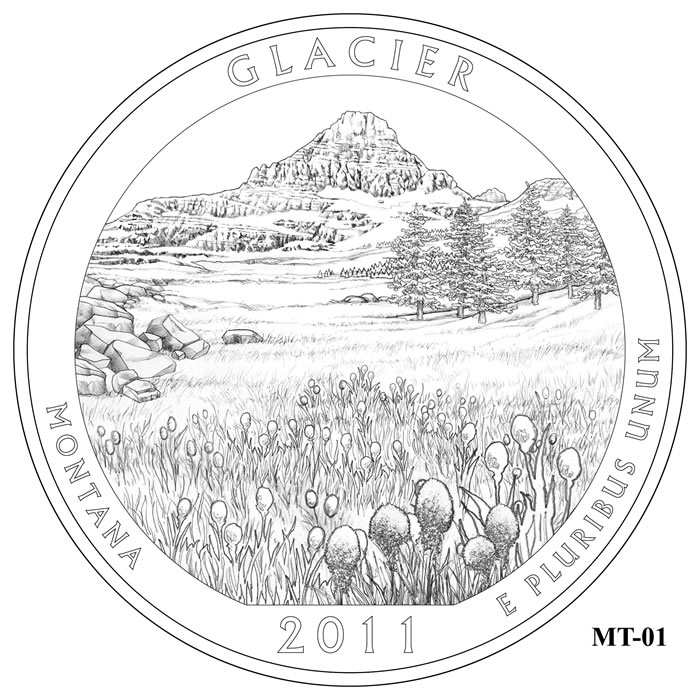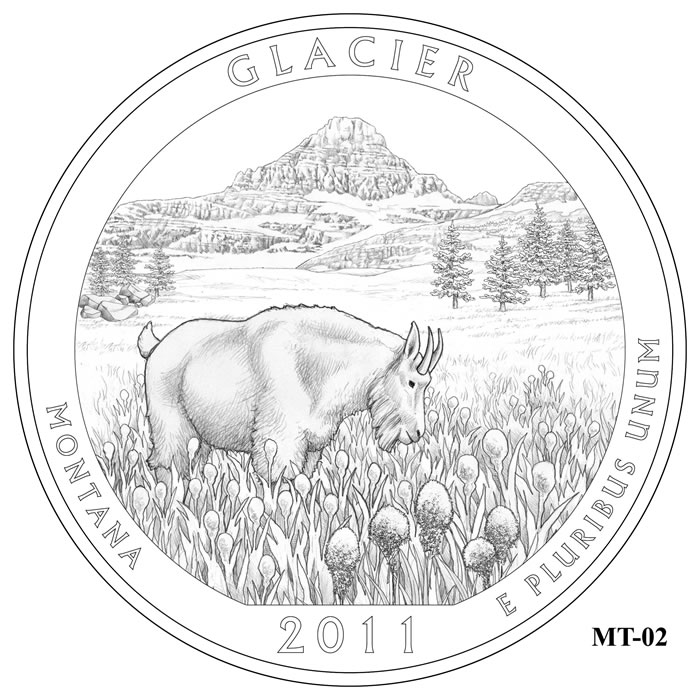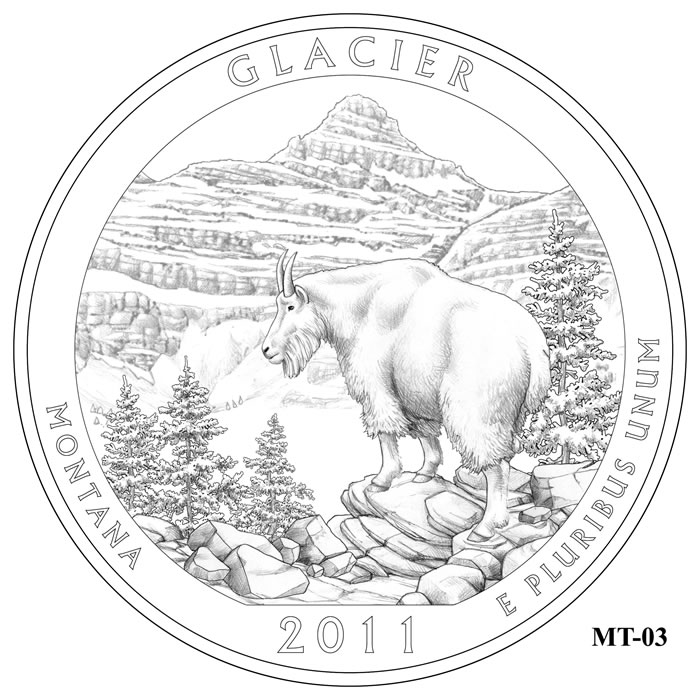The 2011 Glacier National Park Quarter honors the national park located in the state of Montana. It is scheduled to be released into circulation on approximately April 4, 2011 with an official launch ceremony held by the United States Mint to occur within a few days of that release. This strike marks the second to be issued in 2011 as part of the Mint’s America the Beautiful Quarters® Program.
 The final design for the reverse of the Glacier National Park Quarter was chosen by United States Secretary of the Treasury Timothy Geithner from three design candidates given to him by the US Mint. His choice of the three was announced by the Mint on December 1, 2010 with Design Candidate MT-03 selected. It depicts a mountain goat climbing along the rugged terrain of the national park. Off in the distance, the iconic Northeast slope of Mount Reynolds is shown. Surrounding the image are the inscriptions of GLACIER, MONTANA, E PLURIBUS UNUM and 2011. This reverse was designed by AIP Associate Designer Barbara Fox and sculpted by United States Mint Sculptor-Engraver Charles Vickers.
The final design for the reverse of the Glacier National Park Quarter was chosen by United States Secretary of the Treasury Timothy Geithner from three design candidates given to him by the US Mint. His choice of the three was announced by the Mint on December 1, 2010 with Design Candidate MT-03 selected. It depicts a mountain goat climbing along the rugged terrain of the national park. Off in the distance, the iconic Northeast slope of Mount Reynolds is shown. Surrounding the image are the inscriptions of GLACIER, MONTANA, E PLURIBUS UNUM and 2011. This reverse was designed by AIP Associate Designer Barbara Fox and sculpted by United States Mint Sculptor-Engraver Charles Vickers.
Before the Treasury Secretary made his decision, the US Mint submitted the three design candidates for review by the Citizen’s Coinage Advisory Committee (CCAC) and the United States Commission of Fine Arts (CFA). Both groups are charged with the task of making design recommendations for upcoming coinage from the US Mint. Their comments, along with that of the US Mint Director, were taken into consideration by Timothy Geithner before a final decision was made.
 |
 |
 |
When the CCAC met on January 26, 2010 to review the three design candidates for the Glacier National Park Quarter, it recommended MT-03 which eventually was chosen to be used for the quarter itself. In their comments, the CCAC stated "Members were enthusiastic about the combination of an iconic mountain goat with the grandeur of the mountains, and felt that this design would translate into a very appealing coin."
The CFA also chose MT-03 for the Glacier National Park Quarter when the had their meeting on January 21, 2010 to select a design. The commission commented that the "Rocky Mountain goat is emblematic of the park and provides a desirable foreground feature that gives scale to the sweeping vista of the glaciated landscape."
Glacier National Park information
Glacier National Park is composed of over 1 million acres of scenic land in the northwest corner of the state of Montana. Found within the park’s boundaries are hundreds of lakes, with only 130 of them named including Lake McDonald and St. Mary Lake, the two largest of the park.
A thousand different species of plants and animals are also located within Glacier that have survived mostly untouched for centuries. Thus, the park has a uniquely endemic ecosystem offering a glimpse into the past.
Only two historic animal species of the area are not currently present within the park – the bison and the woodland caribou. That still leaves sixty-two species of mammals still present in the region which join another 260 species of recorded birds.
The park itself owes a great deal of its protection to the Great Northern Railway which saw the region as a huge scenic draw for its customers. To promote that possibility, the railway lobbied Congress for protection of the resources of Glacier which was partially achieved when it was named a forest preserve in 1897. Finally, on May 11, 1910, President William Howard Taft signed the legislation creating Glacier National Park.
Today, the park receives over two million visitors annually. Most who visit take the time to drive or ride on the scenic 53-mile Going-to-the-Sun Road which was completed in 1932. The road is typically closed from mid-October until June as high levels of snow make travel impossible.
